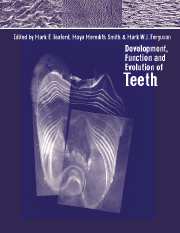Book contents
- Frontmatter
- Contents
- List of contributors
- Acknowledgements
- Part one Genes, molecules and tooth initiation
- Part two Tooth tissues: development and evolution
- Part three Evolution of tooth shape and dentition
- 10 Evolutionary origins of teeth and jaws: developmental models and phylogenetic patterns
- 11 Development and evolution of dentition patterns and their genetic basis
- 12 Evolution of tooth attachment in lower vertebrates to tetrapods
- 13 Tooth replacement patterns in non-mammalian vertebrates
- 14 The evolution of tooth shape and tooth function in primates
- 15 ‘Schultz's Rule’ and the evolution of tooth emergence and replacement patterns in primates and ungulates
- Part four Macrostructure and function
- Index
12 - Evolution of tooth attachment in lower vertebrates to tetrapods
Published online by Cambridge University Press: 11 September 2009
- Frontmatter
- Contents
- List of contributors
- Acknowledgements
- Part one Genes, molecules and tooth initiation
- Part two Tooth tissues: development and evolution
- Part three Evolution of tooth shape and dentition
- 10 Evolutionary origins of teeth and jaws: developmental models and phylogenetic patterns
- 11 Development and evolution of dentition patterns and their genetic basis
- 12 Evolution of tooth attachment in lower vertebrates to tetrapods
- 13 Tooth replacement patterns in non-mammalian vertebrates
- 14 The evolution of tooth shape and tooth function in primates
- 15 ‘Schultz's Rule’ and the evolution of tooth emergence and replacement patterns in primates and ungulates
- Part four Macrostructure and function
- Index
Summary
Introduction
During the evolution of teeth, different types of periodontal attachment have been developed. It is likely that teeth have either evolved from conodont elements (Figure 12.1) or from denticles of the odontode type (Figure 12.2) in the earliest agnathic chordates (Krejsa and Slavkin, 1987; Smith and Hall, 1990) before the dermal armour and tooth-like placoid scales appeared during the evolution of fishes (Gross, 1966). A new developmental model has been proposed on the basis of separation of odontogenic from osteogenic and chondrogenic neural crest potential (Smith and Hall, 1993). It is explained as a modular development, where each interactive morphogenetic unit may be commited to form either cartilage, bone, odontodes, or teeth (see Chapter 10).
The mode of tooth attachment in lower vertebrates constitutes a rather small spectrum which ranges from the loose fibrous type seen in the elasmobranchs to solid ankylosis between the tooth and the underlying jaw (Peyer, 1968). However, other highly complex types of attachment structures were developed mainly in bony fishes at a relatively late stage in the evolution of teeth. The mammalian periodontium could be regarded as the most complex of all types of tooth attachment, particularly in regard to structure and function (Shellis, 1982; Osborn, 1984; Berkovitz et al., 1992, 1995). However, even in the thecodont mammals there are major differences in periodontal reactivity between rodent, carnivorous, herbivorous and omnivorous dentitions because of apparent differences in the fine structure of the periodontium, in the mode of tooth replacement and in the eruption and growth rate of teeth.
- Type
- Chapter
- Information
- Development, Function and Evolution of Teeth , pp. 173 - 185Publisher: Cambridge University PressPrint publication year: 2000
- 33
- Cited by



